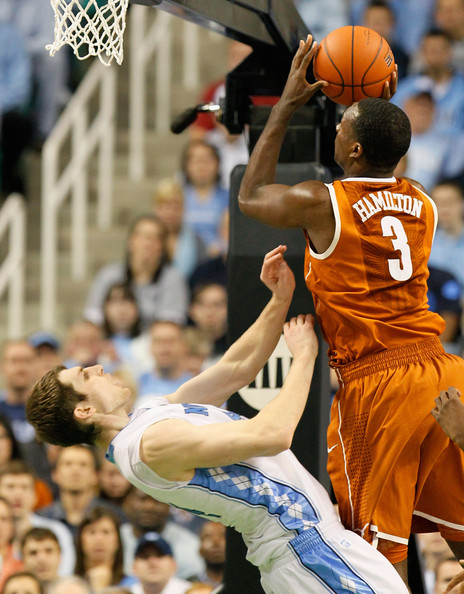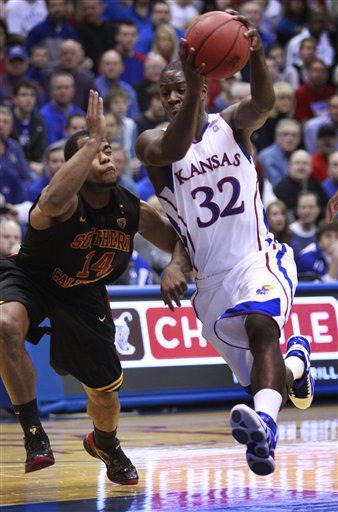Another Pro-or-No and our first from the Big XII…okay I’m sorry but are we going to start referring to some of these conferences as something else soon or are we assuming nothing will change with all the expansion over the past year?
Anyways, we’re looking at a couple of dynamic sophomore scorers and a controversial and intriguing freshman.
Jordan Hamilton, Texas, So. – SF

Can Hamilton score like he did in Austin but with more efficiency?
Overview – Scouts and college coaches have known how talented a basketball player Jordan Hamilton is for quite awhile. The guy just knows how to flat out score. He has deeeeeeep range on his jump shot. Can drive the ball to the rim and finish in traffic. He has a good mid-range game. His scoring abilities are hard to argue with and are the very reason he was the number one ranked SF coming out of high school in 2009 when he enrolled at Texas. Yet when the 6-7, 220 pound Hamilton struggled at times his freshmen season, scouts weren’t that surprised. Despite his incredible scoring, he has been known to take a lot of dumb shots, lose focus on the defensive end, and not always give a great effort rebounding. Instead of becoming a “one-and-done” player, Hamilton returned and took his game to a new level and really improved his effort on the glass and on defense. However, he still showed that he could be a “ball-stopper” in the NBA who had a knack for taking ill-advised shots and not being a facilitator. Nevertheless, he will likely be a late lottery to mid-first round pick.
Best Case– Hamilton gets drafted at the end of the lottery by Phoenix. With veterans like Steve Nash and Grant Hill guiding him, Jordan learns how to become an efficient scorer and play with a higher basketball IQ his first season. His defensive abilities are still average (which is essential First-Team All Defense for the Suns), but he rebounds like he did his sophomore year for the Horns. He becomes a Corey Maggette clone, except he has the jump shot that can take his game to the next level and leaves Phoenix a piece to build around once Nash and Hill retire.
Worst Case– He’s drafted by the Bobcats and becomes a poor-man’s Stephen Jackson (man that’s bad). He models his game after his teammate and puts up gaudy offensive numbers but with horrendous efficiency. The Bobcats finish with the worst-record in the NBA and get the number one overall pick where MJ drafts fellow Tar Heel Harrison Barnes. Barnes takes almost all of Hamilton’s minutes and Hamilton is forgotten and known as the younger version of Stephen Jackson as he bounces from bad team to bad team throughout his career.
Alec Burks, Colorado, So. – SG

Driving? Check. Jump shot? TBD.
Overview– While Hamilton was a well-known commodity coming out of high school, Burks was a little less noticed. Despite being the Gatorade Missouri Player of the Year, he was lightly recruited and ended up in Boulder (Mizzou fans must think Mike Anderson was already in contract talks with Arkansas and didn’t have time to recruit in-state). Buffalo fans certainly weren’t disappointed. Burks immediately showed how smooth of a scorer he can be, whether in the half-court or in transition. While not possessing the best outside shot, he can get to the rim with either hand using an amazing quick first-step. He rebounds incredibly well for a 6-6 guard grabbing 6.5 rebounds a game this past year. But he does have his flaws despite being a likely lottery pick. Burks handled the ball a lot at Colorado but didn’t score as effectively when he didn’t have the ball and as was previously mentioned- doesn’t shoot well from outside (under 30% from 3-pt land).
Best Case– Milwaukee grabs him with the 10th pick and hopes he can provide more efficient scoring at the 2. Burks realizes that developing an outside shot is the key to his game and shows much improvement during his rookie year. Now armed with a legitimate range, Burks becomes a lethal scorer and has the young Bucks battling the Bulls for the Central division. Burks’ ability to score with-or-without the ball has numerous NBA GMs regretting their decisions to pass on him. He finishes 2nd in the NBA rookie of the year award to Derrick Williams, but Milwukee fans are ecstatic- they have their shooting guard for the future.
Worst Case– The jump shot never develops. His ability to slash and score with the ball in transition allows him to be a contributor similar to Ronnie Brewer but his defense isn’t quite at the same level. He goes to the Pacers and simply replaces Dahntay Jones as Indiana’s second-team scoring guard. Not labeled a bust by most, but certainly a disappointing mid-first round pick.
Josh Selby, Kansas, Fr. – PG…who are we kidding? – SG

Selby needs to become a better pure point guard.
Overview – Two words come to mind when thinking of Josh Selby: potential and maturity. Let’s start with the latter. Selby has shown a lack of maturity as he took “impermissible benefits” and was suspended for Kansas’ first 9 games this year. He also all but sealed his entrance into the NBA draft when he started training in Las Vegas while class was in session. Maybe, that was someone giving him bad advice, but Selby definitely should have returned to school to improve his draft stock. But what’s done is done. So let’s talk about the former and why NBA scouts will take a chance on him. Selby has TONS of potential. He’s got great size for a point guard (terrible for a shooting guard). He has incredible athleticism and gets after it on the defense, which could be his greatest asset right now considering the abundance of elite point guards in the league. He shows flashes of great jump shooting ability and the ability to blow by his man and get to the basket. But even with all those signs of potential, he didn’t really do that well at Kansas this year which will have scouts wondering. And with his lack of true point guard instincts, is he ultimately just a tweener?
Best Case– The Heat select Selby with the first pick of the second round after losing to the Celtics in seven after Rondo continuously gets to the rim at will. With Lebron and Dwayne directing Selby, he excels at what he’s asked to do as an off-the-ball point guard: hit open shots that they create for him and lock down opposing team’s point guards. The Heat are scary good with a surprisingly mature Selby accepting his role. Miami wins the NBA championship (much to the dismay of 98% of the world) and Selby’s defense on Rondo, DRose, and Russell Westbrook is the reason why. Selby improves year after year and is no longer just a role player for the Heat and has entered the “Elite Point Guard Pantheon of the NBA.”
Worst Case – Selby gets drafted late in the second round as most GMs don’t think he can develop into a true point guard and has some maturity issues. Selby’s play in his limited spot appearances prove them right as he dribbles too much and forces some idiotic shots. After a couple of lackluster seasons, he tries his luck in Europe where he enjoys moderate success as a scoring 2 where his lack of size isn’t as debilitating to his game.





